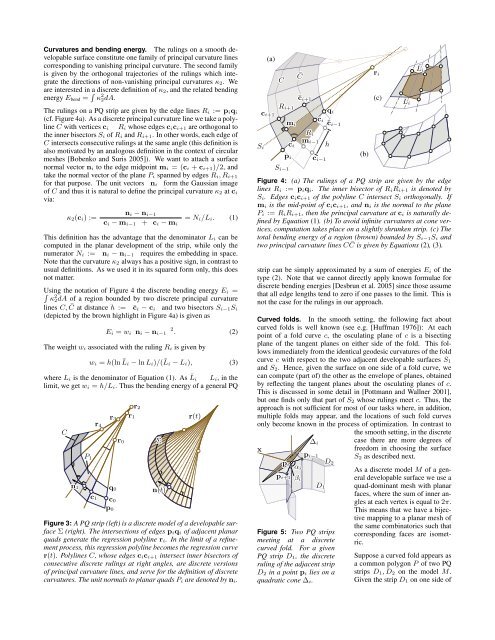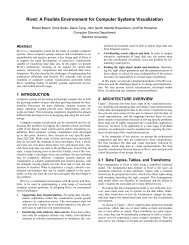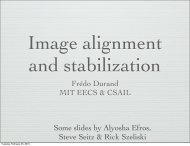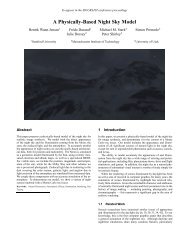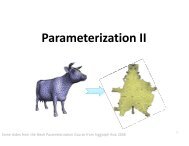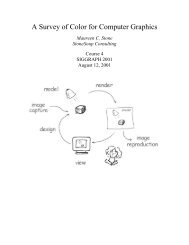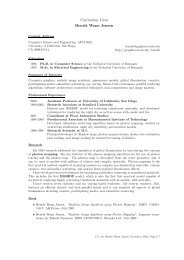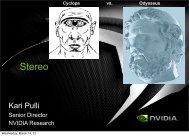Curved Folding - Computer Graphics Laboratory
Curved Folding - Computer Graphics Laboratory
Curved Folding - Computer Graphics Laboratory
You also want an ePaper? Increase the reach of your titles
YUMPU automatically turns print PDFs into web optimized ePapers that Google loves.
Curvatures and bending energy. The rulings on a smooth developable<br />
surface constitute one family of principal curvature lines<br />
corresponding to vanishing principal curvature. The second family<br />
is given by the orthogonal trajectories of the rulings which integrate<br />
the directions of non-vanishing principal curvatures κ2. We<br />
are interested in a discrete definition of κ2, and the related bending<br />
energy Ebend = R κ 2 2dA.<br />
The rulings on a PQ strip are given by the edge lines Ri := piqi<br />
(cf. Figure 4a). As a discrete principal curvature line we take a polyline<br />
C with vertices ci 2 Ri whose edges cici+1 are orthogonal to<br />
the inner bisectors Si of Ri and Ri+1. In other words, each edge of<br />
C intersects consecutive rulings at the same angle (this definition is<br />
also motivated by an analogous definition in the context of circular<br />
meshes [Bobenko and Suris 2005]). We want to attach a surface<br />
normal vector ni to the edge midpoint mi =(ci + ci+1)/2, and<br />
take the normal vector of the plane Pi spanned by edges Ri,Ri+1<br />
for that purpose. The unit vectors fnig form the Gaussian image<br />
of C and thus it is natural to define the principal curvature κ2 at ci<br />
via:<br />
κ2(ci) :=<br />
kni − ni− 1k<br />
= Ni/Li. (1)<br />
kci − mi− 1k + kci − mik<br />
This definition has the advantage that the denominator Li can be<br />
computed in the planar development of the strip, while only the<br />
numerator Ni := kni − ni− 1k requires the embedding in space.<br />
Note that the curvature κ2 always has a positive sign, in contrast to<br />
usual definitions. As we used it in its squared form only, this does<br />
not matter.<br />
RUsing the notation of Figure 4 the discrete bending energy Ei =<br />
2<br />
κ2dA of a region bounded by two discrete principal curvature<br />
lines C, ¯ C at distance h := k¯ci − cik and two bisectors Si− 1Si<br />
(depicted by the brown highlight in Figure 4a) is given as<br />
Ei = wikni − ni− 1k 2 . (2)<br />
The weight wi associated with the ruling Ri is given by<br />
wi = h(ln ¯ Li − ln Li)/( ¯ Li − Li), (3)<br />
where Li is the denominator of Equation (1). As ¯ Li ! Li, in the<br />
limit, we get wi = h/Li. Thus the bending energy of a general PQ<br />
C<br />
n1 n1 n1<br />
n1 n1 n1<br />
P1<br />
r4<br />
c1 c1 c1<br />
c1 c1 c1<br />
r3<br />
q0<br />
c0<br />
p0<br />
r0<br />
r1<br />
r2<br />
ΣΣ<br />
n(t)<br />
n(t)<br />
n(t)<br />
n(t)<br />
n(t)<br />
r(t)<br />
Figure 3: A PQ strip (left) is a discrete model of a developable surface<br />
Σ (right). The intersections of edges piqi of adjacent planar<br />
quads generate the regression polyline ri. In the limit of a refinement<br />
process, this regression polyline becomes the regression curve<br />
r(t). Polylines C, whose edges cici+1 intersect inner bisectors of<br />
consecutive discrete rulings at right angles, are discrete versions<br />
of principal curvature lines, and serve for the definition of discrete<br />
curvatures. The unit normals to planar quads Pi are denoted by ni.<br />
(a)<br />
CC<br />
¯C¯C<br />
¯C¯C ¯C ¯C¯C<br />
¯C¯C ¯C¯C¯C¯C ¯C¯C¯C¯C<br />
pi pi pi<br />
pi pi<br />
qi<br />
qi<br />
pi pi<br />
qi<br />
qi qi qi<br />
Ri Ri Ri<br />
Ri Ri<br />
Ri+1 Ri+1 Ri+1<br />
Ri+1<br />
Ri+1<br />
Ri+1<br />
Ri+1<br />
Ri+1 Ri+1 Ri+1<br />
ci ci ci<br />
Ri Ri<br />
ci<br />
ci ci<br />
ci+1 ci+1 ci+1<br />
ci+1<br />
ci+1<br />
ci+1<br />
ci+1<br />
ci+1 ci+1 ci+1<br />
¯ci ¯ci ¯ci<br />
¯ci− 1<br />
ci ci<br />
ci− 1<br />
¯ci ¯ci ¯ci<br />
¯ci+1 ¯ci+1 ¯ci+1<br />
¯ci+1<br />
¯ci+1<br />
¯ci+1<br />
¯ci+1<br />
¯ci+1 ¯ci+1 ¯ci+1<br />
mi<br />
¯ci ¯ci<br />
mi<br />
mi mi mi<br />
Si Si Si<br />
mi− mi− mi− mi−<br />
mi−<br />
mi− mi−<br />
mi− mi− mi− 1<br />
1<br />
1<br />
1<br />
1<br />
Si<br />
Si Si Si<br />
h<br />
Si− Si− Si− Si−<br />
Si− Si−<br />
Si−<br />
Si− Si− Si− 1<br />
1<br />
1<br />
1<br />
1<br />
(b)<br />
ri<br />
(c)<br />
Li Li Li<br />
Li Li Li<br />
¯Li ¯Li<br />
¯Li ¯Li<br />
¯Li ¯Li ¯Li ¯Li<br />
¯Li ¯Li ¯Li ¯Li<br />
¯Li ¯Li ¯Li<br />
¯Li<br />
Figure 4: (a) The rulings of a PQ strip are given by the edge<br />
lines Ri := piqi. The inner bisector of RiRi+1 is denoted by<br />
Si. Edges cici+1 of the polyline C intersect Si orthogonally. If<br />
mi is the mid-point of cici+1, and ni is the normal to the plane<br />
Pi := RiRi+1, then the principal curvature at ci is naturally defined<br />
by Equation (1). (b) To avoid infinite curvatures at cone vertices,<br />
computation takes place on a slightly shrunken strip. (c) The<br />
total bending energy of a region (brown) bounded by Si− 1Si and<br />
two principal curvature lines C ¯ C is given by Equations (2), (3).<br />
strip can be simply approximated by a sum of energies Ei of the<br />
type (2). Note that we cannot directly apply known formulae for<br />
discrete bending energies [Desbrun et al. 2005] since those assume<br />
that all edge lengths tend to zero if one passes to the limit. This is<br />
not the case for the rulings in our approach.<br />
<strong>Curved</strong> folds. In the smooth setting, the following fact about<br />
curved folds is well known (see e.g. [Huffman 1976]): At each<br />
point of a fold curve c, the osculating plane of c is a bisecting<br />
plane of the tangent planes on either side of the fold. This follows<br />
immediately from the identical geodesic curvatures of the fold<br />
curve c with respect to the two adjacent developable surfaces S1<br />
and S2. Hence, given the surface on one side of a fold curve, we<br />
can compute (part of) the other as the envelope of planes, obtained<br />
by reflecting the tangent planes about the osculating planes of c.<br />
This is discussed in some detail in [Pottmann and Wallner 2001],<br />
but one finds only that part of S2 whose rulings meet c. Thus, the<br />
approach is not sufficient for most of our tasks where, in addition,<br />
multiple folds may appear, and the locations of such fold curves<br />
only become known in the process of optimization. In contrast to<br />
x<br />
∆i<br />
D2<br />
D2<br />
D2 D2 D2<br />
αi αi αi<br />
αi αi<br />
pi− pi− pi− pi−<br />
pi− pi− pi−<br />
pi− pi− pi− pi− 1<br />
1<br />
1<br />
1<br />
pi pi pi<br />
αi αi<br />
pi<br />
pi pi pi<br />
βi βi βi<br />
βi βi<br />
pi+1 pi+1 pi+1<br />
pi+1<br />
pi+1<br />
pi+1<br />
pi+1<br />
pi+1 pi+1 pi+1 βi βi<br />
D1<br />
D1<br />
D1 D1 D1<br />
Figure 5: Two PQ strips<br />
meeting at a discrete<br />
curved fold. For a given<br />
PQ strip D1, the discrete<br />
ruling of the adjacent strip<br />
D2 in a point pi lies on a<br />
quadratic cone ∆i.<br />
the smooth setting, in the discrete<br />
case there are more degrees of<br />
freedom in choosing the surface<br />
S2 as described next.<br />
As a discrete model M of a general<br />
developable surface we use a<br />
quad-dominant mesh with planar<br />
faces, where the sum of inner angles<br />
at each vertex is equal to 2π.<br />
This means that we have a bijective<br />
mapping to a planar mesh of<br />
the same combinatorics such that<br />
corresponding faces are isometric.<br />
Suppose a curved fold appears as<br />
a common polygon P of two PQ<br />
strips D1,D2 on the model M.<br />
Given the strip D1 on one side of


